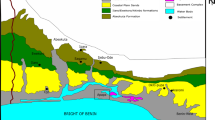Abstract
Effective and efficient practices towards structural management are necessary in order to get appropriate solution to problems pertaining to the maintenance, rehabilitation and safety of hydraulic structures. Majority of the present hydraulic structures in India are withering due to age and hence pose structural deterioration and distress. Suitable planning, assessment and diagnosis are necessary in order to decipher the cause, so as to implement suitable remedial measures to repair and ensure their safety. Distresses in the body of the dam and canals, viz. fissures, volume expansion, deformation, etc., may lead to structural failure, which can be catastrophic both in terms of property and life. The risk of structural failures can be reduced by regular inspections and monitoring, identifying the deficiencies or flaws and accordingly implementation of a comprehensive rehabilitation measure. In the recent past, the awareness towards dam safety has encouraged the development of numerous techniques, which are capable of identifying the location of seepage through body or foundation of hydraulic structures, hence preventing them from disaster. Here the authors have highlighted the effectiveness of an integrated approach towards deciphering of seepage, through well logging and tracer study in hydraulic structures; and the remedial measures with relevant case studies. Borehole logging and tracer study forms an integral part of non-destructive technique (NDT); hence, they can be extended for delineating the path of seepage through any hydraulic structure(s).
Access this chapter
Tax calculation will be finalised at checkout
Purchases are for personal use only
Similar content being viewed by others
References
Kamble RK, Panvalkar GA, Chunade AD (2011) Map** seepage in the tailrace channel Bhama-Askhed dam: a case study. Bull Eng Geol Environ 70(4):643–649
Keys WS (1990) Borehole geophysics applied to groundwater investigations, USGS, Denver, USA
Crain ER (Ross) (2004) Crain’s petrophysical handbook. Rocky Mountain House, Alberta, Canada
Pirson SJ (1963) Hand book of well log analysis. Prentice Hall Inc., p 326
Todd DK (1980) Ground water hydrology. Wiley, New York
Moser (1995) Groundwater tracing, tracer technologies for hydrological systems. In: Proceedings of a boulder symposium. IAHS, Publ.no. 229, 119
Gaspar E, Onescu M (1972) Radioactive tracers in hydrology. Elsevier Publications, Bucuresti
Panvalkar GA, Chunade AD (2017) Tracing dam seepage using nuclear logging and tracer techniques—a case study. ISH J Hydraul Eng 311–316.https://doi.org/10.1080/09715010.2017.1376293
Kamble RK, Muralidhar B, Hanumanthappa MS, Patil AV, Edlabadkar JS (2013) Multiple approaches to analyse and control seepage in hydraulic structures. ISH J Hydraul Eng 7–13.https://doi.org/10.1080/09715010.2013.821787
Andrade R, Bhowmick S, Pund A (2017) Tracer an effective tool in detecting canal seepage: case studies from Northern India. Sustain Water Resour Manage 25–31.https://doi.org/10.1007/s40899-017-0083-x
Acknowledgements
The authors bestow their sincere thanks to Shri A.K.Agrawal, Director CW & PRS, for promoting this publication and giving an opportunity to present the same in HYDRO-2021 International Conference.
Author information
Authors and Affiliations
Corresponding author
Editor information
Editors and Affiliations
Rights and permissions
Copyright information
© 2024 The Author(s), under exclusive license to Springer Nature Singapore Pte Ltd.
About this paper
Cite this paper
Andrade, R., Chunade, A., Suresh Kumar, B. (2024). Logging and Tracer Study—An Integral Part of NDT for Seepage Through Hydraulic Structures. In: Timbadiya, P.V., Patel, P.L., Singh, V.P., Manekar, V.L. (eds) Flood Forecasting and Hydraulic Structures. HYDRO 2021. Lecture Notes in Civil Engineering, vol 340. Springer, Singapore. https://doi.org/10.1007/978-981-99-1890-4_40
Download citation
DOI: https://doi.org/10.1007/978-981-99-1890-4_40
Published:
Publisher Name: Springer, Singapore
Print ISBN: 978-981-99-1889-8
Online ISBN: 978-981-99-1890-4
eBook Packages: EngineeringEngineering (R0)




